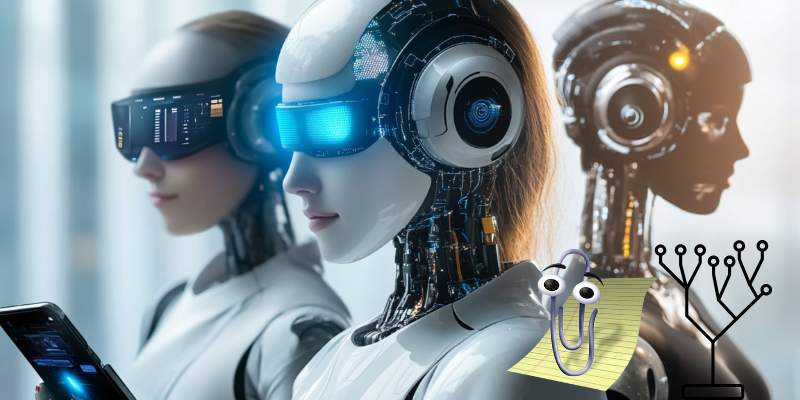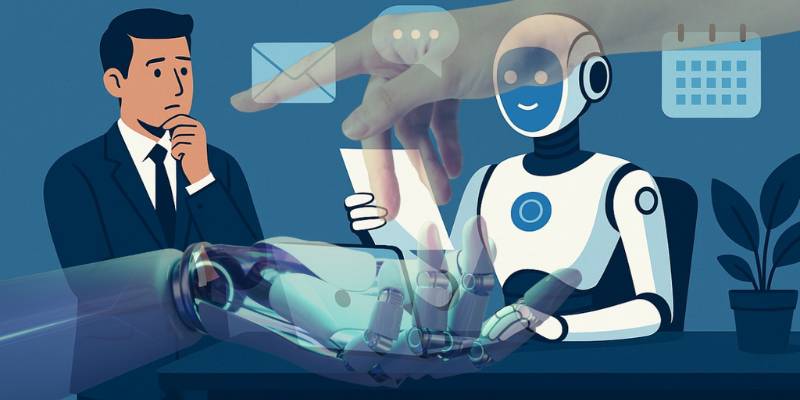The first time I saw a colleague casually ask a chatbot to draft an email that would’ve taken me twenty minutes, I felt two things at once: envy and unease. Envy because, wow, that was fast. Unease because if a machine could handle this so easily, what did that mean for people like me?
This emotional split—excitement and anxiety—is exactly where the debate around AI assistants in the workplace lives today. Are these tools our greatest allies, taking on repetitive work so humans can focus on strategy and creativity? Or are they quietly training us out of our own jobs?
That’s the big question this article will tackle. And while I can’t promise to resolve every worry, I can promise an honest exploration—a mix of personal reflection, industry data, and cultural context. Think of this as both a conversation and a deep dive into The Battle of AI Assistants shaping modern work.
Chapter 1: A Brief History of Workplace Assistants
Before we talk about the “AI” part, it’s worth remembering that assistants in the workplace have always had complicated roles. Executive secretaries, office managers, and administrative aides didn’t just schedule meetings or take calls—they provided a human buffer between chaos and order.
With the arrival of digital tools in the 1990s—think Microsoft Outlook and, yes, even Clippy—the seeds of automation were planted. But those early tools were clunky. They didn’t “understand” context. They followed scripts.
Today’s AI assistants are different. They can learn your preferences, predict your next steps, and handle everything from generating reports to summarizing conference calls. Which is why some people argue we’re entering not just a new chapter, but a new genre of work entirely.
Chapter 2: Productivity on Steroids
Let’s start with the upside: productivity.
- A 2023 McKinsey report found that generative AI could add $2.6 to $4.4 trillion annually to the global economy.
- Another study from PwC estimated that AI-driven automation could boost labor productivity by up to 40% in certain industries.
That’s staggering. Imagine what those numbers mean on a day-to-day level:
- A marketing team using AI to instantly generate social copy.
- A lawyer drafting a first version of a contract with machine help.
- A small business owner finally automating invoices instead of staying up till midnight.
These aren’t hypotheticals anymore—they’re happening every day.
And from my perspective, that’s the seductive side of AI. Who doesn’t want fewer tedious tasks? Who wouldn’t embrace more time for strategy, creativity, or even just a lunch break that isn’t eaten hunched over a keyboard?
Chapter 3: But Wait—What About Jobs?
Here’s the tension: every gain in efficiency sparks a fear of redundancy.
Administrative roles, in particular, face the sharpest scrutiny. It’s why so many people keep coming back to the key insights from Can AI Replace Personal Secretaries? A Deep Dive into Efficiency vs. Human Touch.
Because here’s the truth: while AI can schedule meetings flawlessly, it doesn’t sense the emotional subtext of those meetings.
A human assistant often knows when to protect their boss’s time, when to soften a rejection, or when to remind them gently of a sensitive anniversary.
So the question isn’t whether AI can handle the mechanics of a job—it can. The real question is whether those mechanics are the whole job. And in most human-centered professions, they’re not.
Chapter 4: Understanding The Rise of Voice-First AI Assistants Trends
If you’ve ever asked Alexa to add something to your shopping list, or used Google Assistant to set a timer while cooking, you’re already part of the understanding The Rise of Voice-First AI Assistants trends shaping our habits.
Voice-first assistants are a fascinating case because they blur the boundary between work and life. In offices, voice-driven AI can:
- Book a conference room while you’re walking to another meeting.
- Dictate notes during a brainstorm session.
- Summarize discussions without you ever opening a laptop.
What’s striking is how natural this feels. We’re wired for speech—it’s humanity’s oldest interface. And while typing commands into a chatbot is efficient, saying, “Hey, schedule my client call for tomorrow at 3” feels almost frictionless.
But, of course, this convenience comes with new layers of vulnerability. Which brings us to…
Chapter 5: A Deep Dive into Privacy Concerns
Here’s where I get uneasy again. Convenience is intoxicating, but at what cost?
Voice assistants are often “always listening.” AI workplace tools process sensitive documents, emails, and meeting transcripts. The deep dive into Privacy Concerns is not academic—it’s about our day-to-day trust.
According to a Pew Research study, 72% of Americans worry about how companies use the data collected by AI assistants. And I count myself in that number. I hesitate before asking Siri about certain topics because I don’t fully know where that data ends up.
In a workplace context, this gets even trickier. If your assistant is transcribing confidential board meetings, who owns that transcript? Who gets access? What happens if a competitor hacks the system?
These aren’t science fiction scenarios. They’re active, unresolved challenges. And in my view, if companies don’t tackle privacy transparently, they risk eroding trust before AI assistants even reach their full potential.
Chapter 6: The Human Element—Efficiency vs. Empathy
It’s tempting to talk about AI in terms of numbers, features, and speed. But humans aren’t wired only for efficiency. We’re wired for connection.
Think of a great assistant you’ve worked with—human, not digital. Chances are, what stood out wasn’t just how well they organized your calendar.
It was their empathy. Their ability to pick up on your stress levels, to lighten your load with humor, or to quietly bring you coffee before a big presentation.
No machine replicates that yet. Maybe someday it will simulate it, but simulation isn’t the same as shared humanity.
That’s why, personally, I see AI assistants as amplifiers, not replacements. They make humans more capable, but they don’t erase the need for the human touch.
Chapter 7: Deep Dive into The Battle of AI Assistants
Of course, we can’t ignore the corporate rivalry fueling all this. To deep dive into The Battle of AI Assistants, you only need to glance at the headlines:
- Microsoft’s Copilot integrated directly into Office tools.
- Google’s Duet AI layered onto Gmail and Docs.
- Amazon’s ongoing push to make Alexa relevant beyond the smart home.
- OpenAI’s ChatGPT being adopted as both standalone and enterprise solutions.
Each company pitches its assistant as indispensable. Microsoft emphasizes productivity, Google leans on information mastery, and OpenAI frames it as creativity unleashed.
For workers, this “battle” can feel overwhelming. Which assistant should you trust with your workflow? Will one become the universal standard, or will we juggle three different systems depending on context?
My hunch? Fragmentation will persist, but integration layers will emerge. Think of how many messaging apps we use, yet somehow manage. Assistants will follow a similar path—messy, overlapping, but ultimately workable.
Chapter 8: Emotional Reactions—Hope, Fear, and Everything In Between
I find it impossible to write about this topic without acknowledging the emotional rollercoaster it triggers.
On hopeful days, I see AI assistants as liberators. They free people from tedious work, unlock creativity, and even level the playing field for small businesses without huge teams.
On darker days, I worry about job loss, about humans becoming deskilled, about companies choosing efficiency over dignity.
And maybe that’s the honest truth: both futures are possible. Which one wins out depends less on the technology itself and more on the choices we make—policy decisions, ethical frameworks, and cultural attitudes toward work.
Chapter 9: Solutions and Safeguards
So how do we embrace the productivity without falling into the job-killer trap? A few ideas:
- Retraining Programs: Companies adopting AI should invest in helping employees upskill, not just cut roles.
- Hybrid Workflows: Use AI for mechanical tasks but keep humans in charge of relationship-driven work.
- Transparency: Clear policies on how AI handles data to address the privacy elephant in the room.
- Ethical Guardrails: Industry standards around AI fairness, accountability, and transparency.
None of this is easy, but it’s possible. And in my opinion, it’s essential.
Chapter 10: Looking Ahead
Here’s where I land: AI assistants are neither villains nor saviors. They’re tools—powerful, evolving, deeply influential tools.
In the short term, they’ll boost productivity dramatically. In the medium term, they’ll unsettle certain roles, especially administrative and repetitive ones. In the long term, they’ll force us to redefine what work even means.
The big challenge isn’t whether AI can do the job. It’s whether we, as a society, choose to use it in ways that respect human dignity while embracing technological progress.
And maybe that’s why this topic feels so heavy. It’s not just about jobs—it’s about identity. About worth. About how we, as humans, see ourselves in a world where machines are increasingly capable.
Conclusion
So, productivity boost or job killer?
The uncomfortable answer is: both, depending on how we handle it. AI assistants are extraordinary at removing friction from work. But if companies treat them purely as cost-cutting tools, they risk hollowing out the human side of their organizations.
For me, the path forward is clear. Use AI to free us from drudgery. Use it to give us back time, to amplify creativity, to allow space for empathy and innovation. But never forget that the best workplaces aren’t just efficient—they’re humane.
And no assistant, no matter how advanced, should take that away from us.


